|
Location: South Moravia,
Czech Republic. |
Grid Reference:
48 53' 00'' N, 16 39' 00'' E . |
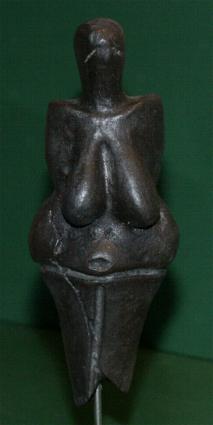
 Dolni Věstonice:
(Gravettian Site)
Dolni Věstonice:
(Gravettian Site)
The site is unique in that it has been a particularly
abundant source of prehistoric artefacts (especially art) dating
from roughly 28,000 to 24,000 B.C
(4). In addition to functional
tools, the artefacts found at Dolni Věstonice include carved
representations of animals, men, women, personal ornaments,
enigmatic engravings. The remains of two dwellings were unearthed:
an oval one (15 x 9m), with five hearths, and a round one (6m in
diameter) with one hearth in the centre in which clay figurines were
fired.
The remains
of two kilns have been uncovered and more than 700
figurines-nearly all depicting Ice Age animals
(1)
such as lions, rhinos, and mammoths-were fired in the oval
earthen kilns of Dolni Vestonice. At nearby sites of similar
age, thousands more terracotta figurines and clay pellets
have been excavated. Almost all the Vestonice figurines
exhibit breaks and cracks-the shattering shock of the flames
that baked them. One hypothesis is that these
figurines had magical significance, and were intentionally
fashioned from wet clay so that they would explode when
fired. The clay would have been mixed either with ash from
certain plants or a different equivalent
The ceramic
figurines and
fragments recovered from Dolni Vestonice have been
identified as representing the earliest known ceramic technology (Vandiver
et al., 1989). The Moravian site �cluster� has yielded
more than 10,000 ceramic fragments. The figurines
recovered from Dolni Vestonice have been dated to 26,000 BP,
while the world�s earliest known pottery vessels until this
time appear
14,000 years later. (3)
The
early origin of ceramic technology at Dolni Vestonice
suggests that the local population were familiar with
their surroundings and have demonstrated an ability to
manipulate and control their environment. If the
ceramics were being produced simply to be shattered via
thermal shock, it can be concluded that the process of
making the objects was more important than the final
product (4).
.
The Venus of Doln�
Věstonice.

The Venus of Doln�
Věstonice is one of the earliest
examples of fired clay sculptures in
the world (c. 28,000�24,000
BC
(4)).
It has four holes in the head, the
function of which is unknown. A Tomograph scan in
2004 found a fingerprint of a child estimated at between 7 and 15
years of age (1)
The She-Shaman.
One of the burials revealed a human
female skeleton, ritualistically placed
beneath a pair of mammoth scapulae, one
leaning against the other. The bones and
the earth surrounding it contained
traces of red
ochre, a
flint spearhead had been placed near
the skull and one hand held the body of
a
fox. This evidence has led to suggestions that
this was the burial site of a
shaman. This is the oldest site not
only of ceramic figurines and artistic
portraiture, but also of evidence of
female shaman.
(More
about Shamanism)
|
The Triple Burial.
(Dolni Věstonice II)
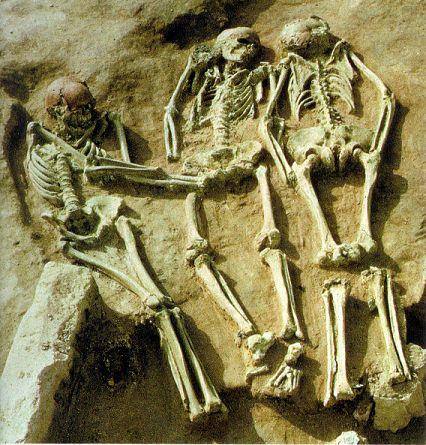
The following extract is J. Shreeve's book
'The Neandertal Enigma: solving the mystery of modern human
origins':
In the spring of 1986, near a village called Dolni Vestonice in the
Czech province of Moravia, the bodies of three teenagers were
discovered in a common grave. A specialist was immediately summoned
from Brno, some twenty-five miles to the north, and under his care
the remains were exhumed and faint remnants of the youths'
identities revealed. Two of the skeletons were heavily built males.
By its slender proportions, the third was judged to be female, aged
seventeen to twenty. A marked left curvature of the spine, along
with several other skeletal abnormalities, suggested that she had
been painfully crippled. The two males had died healthy, in the
prime of their lives. The remains of a thick wooden pole thrust
through the hip of one of them hinted that his death might not have
been entirely natural.
The bodies had been buried with curious attention. According to the
expert Bohuslav Klima, of the Czech Institute of Archaeology in Brno
both young men had been laid to rest with their heads encircled with
necklaces of pierced canine teeth and ivory; the one with the pole
thrust up to his coccyx may also have been wearing some kind of
painted mask. All three skulls were covered in red ochre. The most
peculiar feature of the grave, however, was the arrangement of the
deceased. Whoever committed the bodies to the ground extended them
side by side, the woman between her two companions. The man on her
left lay on his stomach, facing away from her but with his left arm
linked with hers. The other male lay on his back, his head turned
toward her. Both of his arms were reaching out, so that his hands
rested on her pubis. The ground surrounding this intimate connection
was splashed with red ochre.
(2)
Although the gender of the central figure has been
contested recently with suggestions that it is also a male, the
following Journal puts that claim to rest:
|
American Journal of Physical
Anthropology. 2001 Aug;115(4):372-9.
(Quick-link)
The Upper Palaeolithic triple burial
of Dolni Vestonice: Pathology and funerary behaviour.
Formicola V, Pontrandolfi A, Svoboda J.
Department of Ethology, Ecology, and Evolution,
University of Pisa, 56126 Pisa, Italy.
This work focuses on palaeopathological analysis of one
of the skeletons from the Gravettian triple burial of
Dolni Vestonice (Moravia) and addresses issues of Upper
Paleolithic funerary behavior. The burial includes the
well-preserved skeletons of three young individuals.
The skeleton in the middle (DV 15) is pathological and
very problematic to sex; the other two (DV 13 and DV
14) are males and lie in an unusual position. The young
age, the possibility of a simultaneous interment, and
the position of the three specimens have given rise to
speculations about the symbolic significance of this
spectacular and intriguing funerary pattern. The
pathological condition of the skeleton in the middle
further emphasizes its peculiarity. Main pathological
changes of the DV 15 skeleton include: asymmetric
shortening of the right femur and of left forearm bones,
bowing of the right femur, right humerus, and left
radius, elongation of fibulae, dysplasias of the
vertebral column, and very marked enamel hypoplasias.
Scrutiny of the medical literature suggests that the
most likely etiology is chondrodysplasia calcificans
punctata (CCP) complicated by trauma and early fractures
of the upper limbs. CCP is a rare inherited disorder
characterized by stippled ossification of the epiphyses.
The cartilaginous stippling is a transient phenomenon
that disappears during infancy, leaving permanent
deformities on affected bones. Among the different forms
of CCP, the X-linked dominant form is that resulting in
asymmetric shortening and is lethal during early infancy
in males. Thus, survival of DV 15 until young
adult age would require the specimen to be a female.
Clinical findings often associated with the disease (erythemas,
ichthyosis, alopecia, cataracts, and joint contractures,
among others) would emphasize the singular aspect of
this individual, pointing to a condition that should be
carefully taken into account when speculating on the
significance of that peculiar burial.
Copyright 2001 Wiley-Liss, Inc.
|
The Earliest known Example of Woven Fabric:
The surprising discovery of textile imprints at
Pavlov I and Doln� Věstonice I, II attracted attention and opened
discussions. As was the case with ceramics, the textile technologies
were also tested experimentally by Soffer et
al. (2000) who noted the following:
The weavers of Upper Palaeolithic Moravia were not only manufacturing
a variety of cordage types but, more important, also producing
plaited basketry and twined and plain woven cloth which approach
levels of technical sophistication heretofore associated exclusively
with the Neolithic and later time periods.
Unfortunately, much of this technology is evident only to those who
have considerable experience with perishable material culture and
have examined the original evidence first-hand.

On a lump of
fired clay from the Doln� Věstonice / Pavlov area were found the
impressions of substances from plant fibres. The whole process of
picking nettles, crushing the dried stem, preparation of tow,
spinning the thread and then weaving was tested and shown to be
possible using tools of the time by M. Bunatova.
Urbanov� (ca 1999)
(Image
Credits: Donsmaps.com)
Article: BBC NewsOnline: (June, 2000).
Woven cloth dates back 27,000 years.
Woven clothing was being produced on looms
27,000 years ago, far earlier than had been thought, scientists
say... ...The evidence was obtained from a number of sites in
the Czech Republic... ...Some of the fibre impressions may have
been made accidentally, such as by sitting on a fresh clay floor
or when wet clay was carried in woven bags. "Other impressions
may have been caused by deliberate action, such as lining a
basket with clay to make it watertight," said Professor Soffer.
A detailed examination of the impressions
reveals a large variety of weaving techniques. There are open
and closed twines, plain weave and nets. Professor Soffer told
BBC News Online that twining can be done by hand but plain weave
needed a loom. It may be that many stone artefacts found in
settlements may not be objects of art as had been supposed but
parts of an ancient loom, which should now be considered as the
first machine to be made after the wheel... ...Further
revelations are to be expected in this area of research. There
are recent reports that fragments of burnt textiles have been
found adhering to pieces of flint.
(Click
here for Full Article)
Selection of Objects
Recovered from Dolni Vestonice.
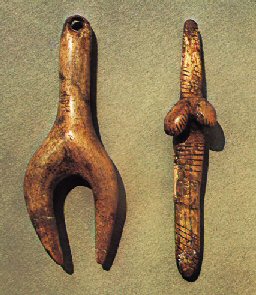
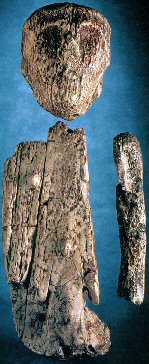
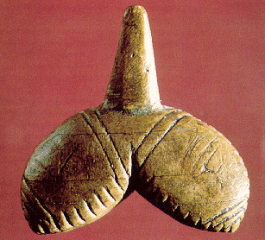
Carved ivory objects. (The central figure is a
marionette)
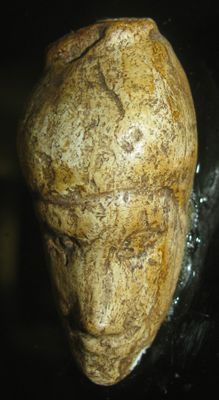
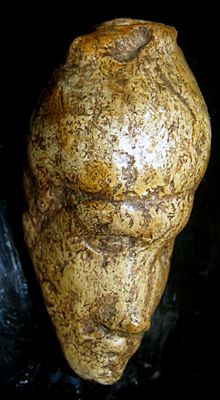

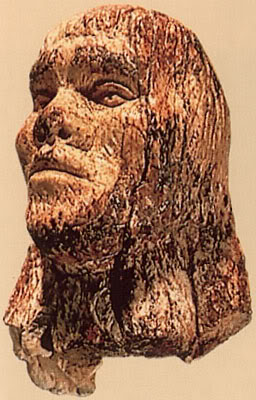
Carved mammoth-bone heads.

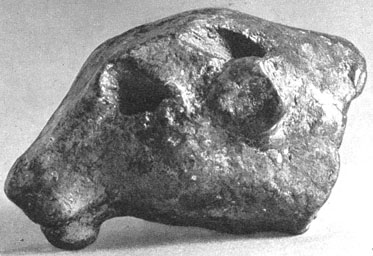
Pottery heads of
animals. (The two holes in the lions head run right through).
(Prehistoric
Cave-art)
(Venus
Figurines)
|












